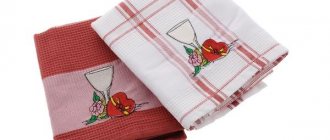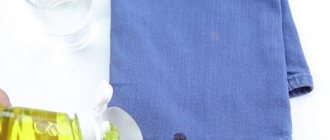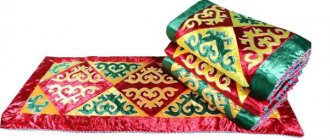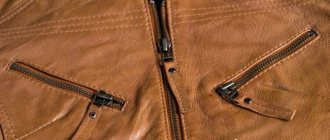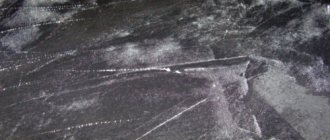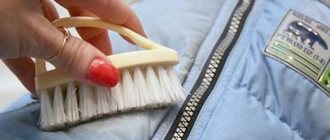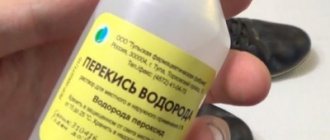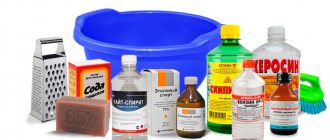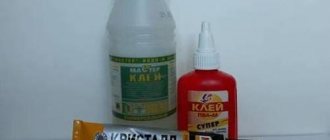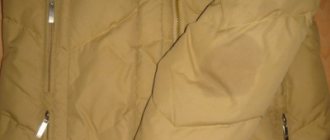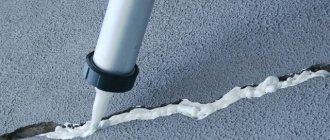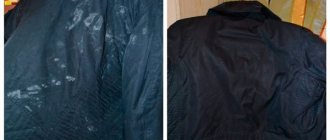Car owners often encounter various kinds of pollution. In most cases, these are stains from diesel fuel, gasoline or fuel oil. This article will tell you how to remove a fuel oil stain from a jacket. Don't be upset about this in advance.
It doesn’t matter if dirt appears on work or “garage” clothes. It’s much worse when a windbreaker or down jacket for everyday wear, and even a light shade, gets dirty.
How to remove a fresh fuel oil stain from a jacket or down jacket
Fresh stains from fuel oil that appear on a jacket or down jacket are easier to remove than old stains.
It is important to know how to wash fuel oil from a jacket at home
The following methods and means are suitable for cleaning:
- Clean the fuel oil with a cotton pad and blot the area with a cloth soaked in eucalyptus oil. The fuel oil will begin to gradually dissolve. Wash the item.
- Spread a fresh stain with vegetable oil or margarine. A solution of dish soap will help remove any remaining grease. Wash with plenty of water.
- Effectively copes with soda contamination. It is necessary to wash the area in cold water with soda, and then soak the jacket or down jacket in clean water for several hours. For further washing, use powder or washing soap.
The final wash of the product is done in a washing machine.
General rules for removing fuel oil stains from clothing
A thing stained with fuel oil must be removed not only from the oily dark stain, but also from the sharp unpleasant odor that cannot be ignored. The simplest method of cleaning clothes is to go to a dry cleaner, where all types of contaminants are removed using special products. Unfortunately, professional cleaning services are not cheap, and you don’t always have time to wait for the item to be returned, so you have to deal with the problem yourself. Before removing a fuel oil stain from a jacket, you should study the procedure for carrying out the work and become familiar with the basic rules:
- The cleaning composition is tested on a small area of clothing or a sample of the fabric from which the item is made.
- Oil stains are removed with a cotton pad, directing movements from the periphery to the center and changing the swab as it gets dirty.
- Apply a means for cleaning fuel oil from the inside out, while a clean sheet of paper or a piece of cloth must be placed on the front side to prevent the appearance of prints on another part of the product.
It is not always possible to remove fuel oil stains from clothes. If fuel oil gets on dense matter, then there is a chance to try several ways to remove it, including using aggressive substances. Delicate natural and synthetic fabrics are more difficult to wash, since the choice of products is limited, and the properties of the material do not allow physical effort to rub off the stain.
On a note! Fuel oil is a by-product of petroleum distillation. The chemical properties of the substance promote rapid penetration into fabric fibers, leading to the appearance of persistent stains, which are best dealt with by products with oil-based solvent properties or adsorbents.
Removing fresh fuel oil stains
The procedure depends not only on the density of the material and type of clothing, but also on the time the stain appears. It is easiest to remove fresh drops of fuel oil before the fabric fibers become saturated with the oily substance. Emergency help consists of using cleaners with adsorbing properties, which are applied to the area of contamination. Among the folk remedies, baking soda, salt, tooth or mustard powder, potato starch, loose clay or chalk help well. If you have a special remover for fuel oil, car shampoo, turpentine or tar soap on hand, then a fresh stain on a jacket or trousers should be immediately treated with any of the listed compounds.
Fighting old oil stains
Old stains are always more difficult to wipe off, and cleaning is carried out in several stages. It is unlikely that you will be able to get by with dry cleaning; after removing traces of fuel oil contamination, the item will have to be washed by hand or in a machine wash mode. In order to remove unpleasant odors in addition to traces of fuel oil, you should add a flavored conditioner or table vinegar to the rinse water.
How to remove an old fuel oil stain on a jacket:
- First of all, it is necessary to soften the area of contamination. To do this, use caustic soda, acetone, white spirit, as well as specialized removers.
- It is important to limit the area of exposure to the active substance to the stain only, so as not to damage the surrounding tissue.
After the jacket has been cleaned of traces of fuel oil, you should carry out a regular wash, and if the measures taken were not enough, then resort to more aggressive methods of attacking the stain.
How to remove an old oil stain
An oil refinery product such as fuel oil is very difficult to remove from a textile surface. Especially many problems arise when the pollution is old.
But still, there are several effective ways:
- Soak a cotton swab in purified gasoline and wipe the stain from the reverse side. Complete the cleansing with ammonia. The product must be washed thoroughly.
- If the stain is too old, then you need to pour a little gasoline on the problem area and wait a while for the substance to begin to evaporate. Wash thoroughly in soapy water, then several times in plenty of water.
Read more ► Kitchen grease remover: how to clean kitchen furniture from dirt and stains
Often, for cleaning purposes, a versatile solvent such as acetone or white spirit is used. When interacting with such a product, the material may change color or even be damaged, so it is not advisable to use extreme methods on colored and synthetic fabrics.
Precautionary measures
If you notice a fuel oil stain on your clothes, you want to quickly wipe it off. This is correct, because fresh stains come off better. But many people do this with improvised means (napkins, hands, etc.), thereby smearing the dirt even more and rubbing it into their favorite T-shirt or pants. You cannot clean clothes this way, otherwise there is a risk of irreversibly damaging the item.
To prevent this from happening, the following methods will tell you how to remove fuel oil:
- If you place an item on a surface and begin to rub it, the dirt will be imprinted on the other side of the fabric. To prevent this from happening, you need to put a towel or any other thick piece of fabric on the back side (which you won’t mind later).
- It is more convenient to apply the product from the wrong side of the item, placing an unnecessary flap on the front side. This way you won’t rub dirt into the fibers, but on the contrary, you’ll get rid of it faster.
- Since fuel oil has an oily base, rubbing such a stain with a cleaning agent may spread it over a large surface. Oil contours are difficult to get rid of, so it is advisable to treat the fabric around the stain with a solvent in advance. Attention! The method is not suitable for all types of fabrics.
- When using aggressive agents (ammonium, gasoline, acetone, etc.), follow safety precautions. The label of each specific product indicates what precautions are needed. In some places it is enough to just use gloves, but in others you need a mask and goggles. In any case, the room should be ventilated, and there should be no sources of fire or things nearby that could be damaged if solutions get on them.
- Other oil stains are often sprinkled with salt to remove them. This will not work with heating oil, it will only dry out the contamination and make it harder to clean.
How and with what to remove fuel oil from jeans?
Outerwear is often made from denim, so it is worth considering this cleaning option on an individual basis.
Method for removing fuel oil from denim:
- You need to prepare a mixture of turpentine, starch, and ammonia. Liquid components are taken in a 1:1 ratio. Starch is added until the mass becomes porridge-like.
- Apply the paste to the stain for 1 hour. During this time, the problem area should lighten significantly. It is important to ensure that the stain is not absorbed into another part of the item.
- Remove the porridge and treat the area with a weak solution of vinegar and water. Moisten the disc with the prepared product and wipe the stain.
- Wash the product in soapy cold water 3 times.
If this option does not help, then only gasoline will remain, which can easily damage fabric fibers.
Pay attention to the type of clothing
Before you begin the procedure for removing oil stains, you need to decide what cleaning agent you will use, whether it is suitable for the fabric and whether it can clean it. It is clear that it is easier to wash jeans from fuel oil than, for example, a cashmere sweater. Even some aggressive methods are used on denim, and delicate materials will not survive such treatment.
Natural fabrics wash better than synthetics, but for delicate fabrics you still need to use gentle products, for example, fir oil or soda. When it is possible to pre-check the reaction of the material to the product, do it! Inconspicuous areas of clothing are suitable for this - seam allowances, hems, etc. Along with some types of products, the kit includes a piece of fabric that is sewn to the collar or side.
Outerwear - down jacket, coat and jacket - must be checked for compatibility with the cleaning product. Try not to use aggressive products, even if it is overalls - outerwear has many layers (filling, lining, outer fabric) that can react differently to cleaning. In addition, many of the products have a difficult-to-remove odor (for example, gasoline or kerosene), which will be absorbed inside. For old clothes from the garage, this may not matter, but if we are talking about everyday clothes, then this will be a serious minus. If a sheepskin coat or fur coat with natural or artificial fur gets dirty, it is better not to even try to remove the fuel oil yourself, but to immediately take the item to dry cleaning.
Soiled rag shoes (for example, sneakers) are treated in the same way as clothing made from the same materials.
How and with what to wash fuel oil from white clothes?
It is very difficult to remove oil stains from snow-white clothes, but there is one effective way:
- Dissolve 200 g of caustic soda in 10 liters of water.
- Soak clothes in the solution for 2 hours.
- Wash the product.
If the stain is too old, it is advisable to use alcohol first. Use a napkin soaked in alcohol to wet the fabric, and then soak it in a solution with caustic soda. The procedure is simple and does not require large work resources.
How can you scrub it off?
Based on the above recommendations, you can easily choose a way to get rid of such an unpleasant situation as a fuel oil stain. It is worth considering a few more important factors that will help you put your favorite things in order without much effort and at home.
With different types of fabric
It is important to remember that there is no one-size-fits-all approach to cleaning different types of fabrics. For example, to combat stains on rough denim, almost any product is suitable
If the stain is small, then an ordinary detergent can remove it without any problems, but if the stain is large, more stringent methods of dealing with it will be needed.
In the situation with jeans, it is quite acceptable to use solvents, acetone and even purified gasoline or kerosene. It is enough just to apply the selected product to the stain and leave for an hour. After this, it will be quite easy to wash it with ordinary soap or washing powder. Such products can only be used with gloves.
In the case of bologna you need to be more careful
To remove a fuel oil stain from your favorite Bolognese jacket, you can also use almost all of the above remedies, but with great care. It’s worth trying more gentle methods first so as not to damage the fabric structure.
It is extremely undesirable to apply friction to it, because intense friction causes the bologna to become very thin and can quickly break through.
In addition, it is quite difficult to see the end result on bolognese fabric, because it has the property of becoming stained and speckled at the slightest wetness, so you definitely cannot do without washing the entire product.
Here only household chemicals and patience will come to the rescue: most likely you will need several washes. You can consider washing with eucalyptus essential oil or ammonia, but even with these products you need to be extremely careful, since delicate tissues can be damaged even by such seemingly harmless substances.
From white and colored materials
It is very difficult to say which scanner is more difficult to remove fuel oil contamination from: white or colored. On the one hand, such a stain is too obvious on white fabric, but on the other hand, when cleaning colored fabrics there is a high probability of losing the color of the product. In the case of white fabric, it is quite acceptable to use high-quality bleach: if the stain is small and fresh, there is a high probability that a simple wash with bleach will be enough. In a similar situation with colored fabrics, there is a good chance of coping with a good stain remover.
In the case of colored fabric, it is very important to carry out a “test” wash - a fading test. To do this, you need to apply a small amount of the selected product to an inconspicuous area of the product: this can be the inside of a cuff or collar or any other place hidden from the eyes of strangers, and leave for a while
From the skin
In the case of leather goods and shoes, things are a little simpler. Due to its dense structure and smooth surface, the skin absorbs fuel oil much less. It is enough to promptly wipe off the fuel oil from the surface with an alcohol-based damp cloth and the problem can be avoided altogether. It is highly undesirable to wash or dry clean leather products, so it is better to minimize the possibility of such contamination.
If the stain has become ingrained and there is a need to remove it, a car interior cleaner will come to the rescue. Car shampoo is designed to combat this kind of stains; it dissolves grease well and removes the remains of burning and soot from the fuel oil.
Minimal chemical intervention may also be considered. To do this, you can try to wash off the stain with laundry soap or alcohol and paint the product with a special paint for leather: this option will not only help clean the product, but will also update its appearance.
Today there are many options for dealing with difficult stains. Long gone are the days when housewives were forced to scrub and boil laundry for a long time
Today, it is only important to choose the right household chemicals and washing machine for yourself, and you can forget about fighting stains. Laundry has become something simple, it is no longer a labor task for women, even in the case of such complex stains as fuel oil stains
In the next video you will learn about another effective remedy.
Is there a stain remover for fuel oil?
A special substance that will help cope with the problem is a stain remover. The main thing is that the paint of the fabric is not damaged during processing. “Vanish” copes well with this type of pollution.
Tar, bleach and laundry soaps, as well as concentrated washing powders, also cope with fresh versions of oil stains. After pre-treatment, you need to wash white items in bleach.
Read more ► How to remove soot after a fire from ceilings, walls, metal, plastic, windows
Useful tips
- Fuel oil is a product that washes very poorly, but that’s not all the problems. This material also has a very specific unpleasant odor. Therefore, in addition to removing the stain, you need to take care of eliminating the odor. To do this, the item must be soaked for a long period in washing powder and Vanish. When washing, it is recommended to add special products that give things a pleasant smell.
- After removing the stain, the jacket must not be washed with other things, since gasoline has a very pungent odor, which will certainly transfer to other things.
- It is recommended to air dry “saved” items.
- Before you begin to remove dirt, you should place a napkin under it, which will protect the material from imprinting fuel oil on the other side of the clothing.
- Before using any product, it is recommended to first check that it will not harm the item. You need to take the selected product and apply a little of it to the back of the jacket. If it does not eat away the color and does not spoil clothes, then it can safely remove dirt.
- When using gasoline or other toluene-based products, you must wear rubber gloves on your hands, otherwise they may be corroded by the harmful substance.
Conclusions and video
Cleaning clothes from fuel oil stains is not an easy task, but it can be solved. And the sooner you do this, the more effective the result will be. If you can’t get rid of the dirt yourself, then it’s better to resort to dry cleaning services. But when you happen to stain a sheepskin coat, a fur coat or a coat, or clothes made from very delicate fabrics, you should use the services of professionals immediately.
You can wash fuel oil with products that have properties that affect the dissolution of resins and oils. Such substances include ordinary acetone, ammonia, aviation gasoline, baking soda, and turpentine.
Before using a particular substance, it is necessary to determine its effect on a specific tissue. To do this, you need to know that cotton or wool will not withstand the effects of alkali. Artificial viscose or velor will not withstand contact with acids.
Alkaline agents include gasoline and acetone. Acids include ammonia and turpentine. Before using any substance, it is good to realize how deeply the fuel oil has penetrated into the clothing. Depending on the degree of contamination, select an action:
- place the entire thing in the solution;
- Moisten the item only partially with the desired product.
To prevent stains from appearing on clothing, it is better to place a piece of clean fabric under it. Apply the product to the stain carefully. After the cleaning procedure, the item should be washed well. Stain powder and fabric softener will work for best results.
